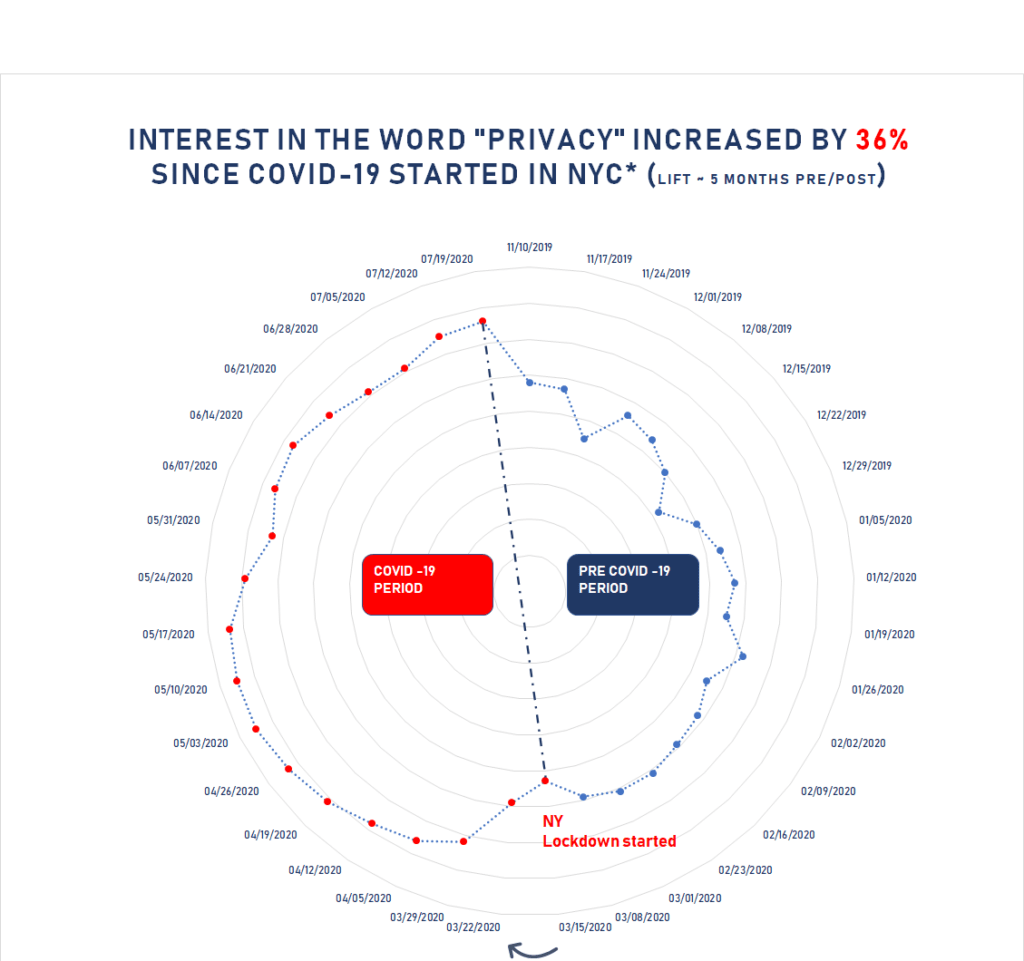Three ways to protect
your brand in turbulent times
It’s a new world for brands and media agencies.
Pre-COVID-19 marketing and advertising, isn’t likely to return for quite some time. As a result of this tumultuous period, decision makers need to reset their approach to consumer privacy.
This means marketers and media buyers must start planning their next steps and strategies in uncharted territory. To do so they must react to how the current business landscape has shifted.
One notable consequence of today’s uncertainty is that the awareness of consumer privacy has increased significantly. Greater attention to privacy will continue to increase as brands navigate within COVID-19 and plan for a new reality. Privacy is gradually becoming a dominant factor in selecting marketing vendors.
To mitigate virus exposure, some countries utilized phone data to intercept outbreak clusters. Yet recent discussions of super spreaders and cluster breakouts have shown prospective or existing customers how easy mobile tracking is. They understand that in matters of life and death, privacy rights can sometimes take a back seat but they will not disregard their privacy for shopping purposes.
Such practices are raising consumer awareness and concerns about the ad industry. In fact, searches of the phrases “safe browsing” and “mobile tracking” increased by around 16% post outbreak in New York City. Google search data in NYC, revealed a 36% increase in the word “privacy” since the lockdown started in mid-March.

Good advertising does not exploit a consumer’s private information (storing personal home addresses, telephones, emails). These data points are known as Personal Identifiable Information (PII). Yet, deriving solid insights and maintaining a high level of privacy, is a tough balancing act and fumbles may occur.
To attain valuable insights and data analytics, major brands and advertising agencies try hard to guard a consumer’s privacy. But at the end of the day, they have limited control as they sub-contract marketing analytics down the vendor chain. Most companies are unaware of the privacy infringements that are literally happening under their noses.
For example, most Smart TVs can track consumers — via picture, sound recognition, cameras, TV viewing patterns and voice activation. In 2017, the consumer electronics company Vizio² was caught eavesdropping on their customers’ viewing habits¹ and sold this data to third-party vendors, including attribution providers hired by major agencies and brands.
This resulted in a relatively small FTC fine. Analytics providers that abuse PII to provide data analytics, are not practicing the art of analytics but are merely spying on customers under the guise of insight.
Since the incident at Vizio and other similar events, the GDPR (General Data Protection Regulation) and CCPA (California Consumer Privacy Act) have surfaced. And the amount of privacy laws and practices is only going to increase in numbers and reach.
The challenge of protecting consumer privacy is not insurmountable nor costly. There are many actionable steps that can be put in place to protect it. And these steps aren’t limited to checking off legal boxes.
While the legal aspects of privacy are obviously important, we need a deeper understanding of what current and prospective consumers expect when transacting or interacting with a company they trust.
Here are the top three ways to protect consumer privacy while seeking data marketing insights:
1. Do a thorough data review.
If you’re the decision maker for a marketing initiative, don’t limit addressing the confidentiality issue to the privacy statements or the end-user license agreements (EULAs). Uninformed consent can be just as damaging as data privacy infringement. Conduct a 360° review of what data is really collected. Is it stored? Reused?
2. Verify privacy practices of analytics and data vendors.
- Are they storing or re-processing any PII in algorithms?
- Is the data from CTVs (Connected TVs), sourced from uninformed consent³ or straightforward unconsented?
- Is there an easy-to-find, opt-out?
3. Don’t underestimate third party-vendors.
- Do they keep customers’ personal data?
- Do they retain PII from surveys?
Neglecting consumer privacy has the capability to devastate your brand beyond repair. This time of change offers an opportunity to adjust how you choose your ad-tech partners and adapt your brand to the new normal. It offers a chance for a transformation that can help protect your brand and treat your customers with even more dignity and respect.
Be Safe.
[1] (https://techcrunch.com/2019/01/07/vizio-settlement-moves-forward ; https://www.theverge.com/2017/2/7/14527360/vizio-smart-tv-tracking-settlement-disable-setting ;
[2] https://www.ftc.gov/news-events/blogs/business-blog/2017/02/what-vizio-was-doing-behind-tv-screens)

